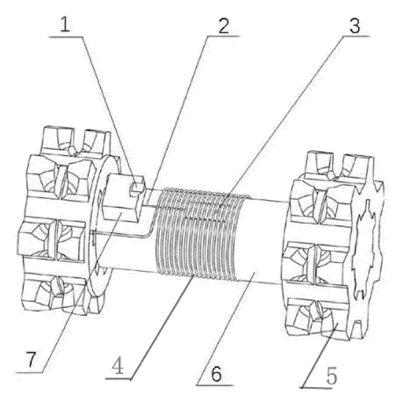| US 11,807,465 B2 | ||
| System for monitoring scarper chain based on measurement on transmittance of torsion spring and method thereof | ||
| Hao Lu, Xuzhou (CN); Hui Jiang, Xuzhou (CN); Zhencai Zhu, Xuzhou (CN); Guohua Cao, Xuzhou (CN); Yuxing Peng, Xuzhou (CN); Gongbo Zhou, Xuzhou (CN); Gang Shen, Xuzhou (CN); Fan Jiang, Xuzhou (CN); Yu Tang, Xuzhou (CN); Xiang Li, Xuzhou (CN); and Wei Wang, Xuzhou (CN) | ||
| Assigned to CHINA UNIVERSITY OF MINING AND TECHNOLOGY, Xuzhou (CN) | ||
| Appl. No. 17/802,188 | ||
| Filed by CHINA UNIVERSITY OF MINING AND TECHNOLOGY, Xuzhou (CN) | ||
|
PCT Filed Jun. 15, 2021, PCT No. PCT/CN2021/100006 § 371(c)(1), (2) Date Aug. 25, 2022, PCT Pub. No. WO2022/188283, PCT Pub. Date Sep. 15, 2022. |
||
| Claims priority of application No. 202110250000.7 (CN), filed on Mar. 8, 2021; and application No. 202110417482.0 (CN), filed on Apr. 19, 2021. | ||
| Prior Publication US 2023/0118041 A1, Apr. 20, 2023 | ||
| Int. Cl. B65G 43/06 (2006.01); B65G 19/20 (2006.01); B65G 43/02 (2006.01) | ||
| CPC B65G 43/06 (2013.01) [B65G 19/20 (2013.01)] | 8 Claims |

|
8. A method for monitoring a scarper chain based on a measurement on transmittance of a torsion spring, characterized by specifically comprising following steps:
S1, initializing an industrial computer, and setting threshold currents I1, I2, I3, I4, I5 and I6 sequentially corresponding to different current values I generated for an illuminated area of a laser sensing panel being of 5%, 25%, 45%, 55%, 75%, or 95%; S2, acquiring, by a signal acquisition device, a current signal I of the laser sensing panel in real time and transmitting the signal to the industrial computer during a normal operation of a scarper conveyor; S3, comparing, by the industrial computer, the obtained current signal I with the different threshold currents, and determining, when I1≤I≤I2, that the illuminated area S of the laser sensing panel is greater than or equal to 5% and less than or equal to 25%, determining, when I2<I≤I3, that the illuminated area S of the laser sensing panel is greater than 25% and less than or equal to 45%, determining, when I3<I≤I4, that the illuminated area S of the laser sensing panel is greater than 45% and less than or equal to 55%, determining, when I4<I≤I5, that the illuminated area S of the laser sensing panel is greater than 55% and less than or equal to 75%, and determining, when I5<I≤I6, that the illuminated area S of the laser sensing panel is greater than 75% and less than or equal to 95%; S4, calculating, by the industrial computer, a range of S through the current signal I obtained in real time, and a varying range of M according to a formula
 when 5%≤S≤25%, M1≤M≤M2; when 25%<S≤45%, M2<M≤M3; when 45%<S≤55%, M3<M≤M4; when 55%<S≤75%, M4<M≤M5; when 75%<S≤95%, M5<M≤M6; and where M denotes a torque acting on the torsion spring, positive and negative signs of values of M denote that whether a direction of the torque is the same as a spiral direction of the torsion spring, E denotes an elastic modulus of a material of the torsion spring, d denotes a diameter of coils of the torsion spring, c denotes an axial length of a number of the working coils of the torsion spring, a denotes a width of the laser sensing panel, b denotes a length of the laser sensing panel, H denotes a stretched length of the torsion spring, n0 denotes an initial number of the coils of the torsion spring, and S denotes the illuminated area of the laser sensing panel; S5, determining, by the industrial computer, that whether the chain of the scraper conveyor is broken or stuck according to the calculated range of S: determining, when I1<I≤I2, that is, M1<M≤M2, or I5<I≤I6, that is, M5<M≤M6, that the chain of the scarper conveyor is broken; determining, when I2<I≤I3, that is, M2<M≤M3, or I4<I≤I5, that is, M4<M≤M5, that the chain of the scarper conveyor is stuck; and determining, when I3<I≤I4, that is, M3<M≤M4, that the chain of the scarper conveyor is operating normally; and S6, repeating Steps S2 to S5 to monitor the chain of the scarper conveyor in real time. |